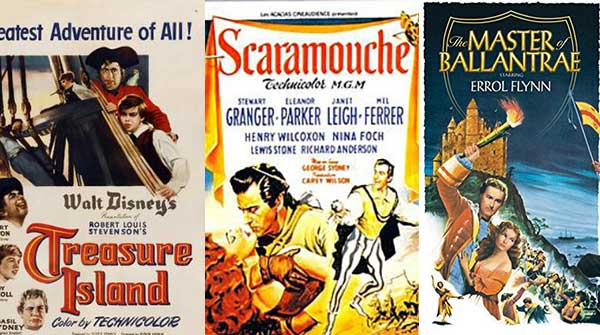Pirates were always reliable entertainment. There was lots of swordplay in swashbucklers
 When my lifelong movie habit began as a child in the early 1950s, adventure was the desired cinematic fare. There should be less talk and more action, preferably involving fights and chases. And please, no kissing!
When my lifelong movie habit began as a child in the early 1950s, adventure was the desired cinematic fare. There should be less talk and more action, preferably involving fights and chases. And please, no kissing!
This made westerns the default favourite, but swashbucklers weren’t far behind. Pirates, of course, were obvious reliables. However, as long as there was lots of swordplay, it didn’t matter.
Here are three that made the grade.
Treasure Island (1950)
Currency controls in the immediate post-war years posed a challenge for Hollywood. Because dollars were so precious, the British government put restrictions on the film companies’ ability to convert ticket sales revenue into dollars for repatriation to the United States. In effect, the funds were “frozen” and could thus only be used in the United Kingdom.
 |
| Related Stories |
| October 1962 a big week for pop culture
|
| Top Gun: Maverick fills the “Need for Speed”
|
| Was Wyatt Earp a righteous lawman or career criminal?
|
One way of putting the money to use was for Hollywood to make movies in Britain rather than in, say, California. Treasure Island was one of those movies.
Written by the Scottish novelist Robert Louis Stevenson, Treasure Island was initially published as a magazine serial in 1881-82, and subsequently in full book-length form in 1883. It was a stirring tale of pirates, buried treasure, betrayal and bravery, which made it just the ticket for capturing a child’s imagination. And the fact that it was told through the eyes of cabin boy Jim Hawkins was icing on the self-identification cake.
There was also the character of Long John Silver, one of the great anti-heroes. Thanks to English actor Robert Newton, Silver set the template for playing roguish pirates. But I must confess to missing the character’s moral ambiguity when I saw Treasure Island as a seven-year-old on a wintry 1952 evening.
Scaramouche (1952)
The source material – Rafael Sabatini’s 1921 novel – begins with the following line: “He was born with a gift of laughter and a sense that the world was mad.” Set around the period of the French Revolution, the story lives up to that introduction.
It’s an involved plot, incorporating aristocratic arrogance, a hero who doesn’t know the identity of his biological father, subterfuge, romance and lots of swordplay. The climactic duel is reputedly the longest ever filmed. Mel Ferrer, who played the hero’s dastardly half-brother, described the related preparation as equivalent to learning a ballet.
Interestingly, MGM’s original intent was to make it as a Gene Kelly musical and the director, George Sidney, always believed that’s how it should have been done. But what eventually emerged was a more conventional swashbuckler starring the then-hot Stewart Granger.
People of varying ages were impressed. Noting the enthralled audience reaction to the extended final duel, the favourable New York Times review had this to say: “With blades ringing in the crowded theatre and blood spurting red from time to time, it makes a mighty pretty picture.”
Master of Ballantrae (1953)
Although once the undisputed king of the swashbucklers, Errol Flynn was on his way down by the early 1950s. The combination of time and overly abundant alcohol had transformed the lithe and athletic performer of the mid-1930s into something less imposing. Still, he more or less got himself together for Master of Ballantrae.
Robert Louis Stevenson was again the original source, this time via his 1889 novel. But the film was, to put it mildly, a loose adaptation.
The story begins in 1745 with Bonnie Prince Charlie’s attempt to recover the thrones of England, Scotland and Ireland for the Stuarts. Two brothers – Jamie and Henry Durie – want to join the rebellion, but it’s decided that one should go and one should stay. That way, the family will have an insurance policy allowing them to preserve their estate regardless of how things turn out. So a coin is tossed and Jamie, the older brother, wins and heads off.
After the rising fails and Jamie is presumed dead, he goes abroad and engages in a spot of piracy. Then, mistakenly believing his brother betrayed him, he returns home, leading to a confrontation and more shenanigans. But it all works out in the end.
This narrative is at odds with Stevenson’s book. Not only is the storyline drastically truncated, but Flynn’s Jamie bears scant resemblance to Stevenson’s. Rather than being heroic, the Jamie in the book is brutal, ruthless and duplicitous. Evil wouldn’t be an overstatement.
However, that would never do for the king of the swashbucklers. Back then, heroes had to be heroic. Audiences wouldn’t have had it any other way.
Pat Murphy casts a history buff’s eye at the goings-on in our world. Never cynical – well, perhaps a little bit.
For interview requests, click here.
The opinions expressed by our columnists and contributors are theirs alone and do not inherently or expressly reflect the views of our publication.
© Troy Media
Troy Media is an editorial content provider to media outlets and its own hosted community news outlets across Canada.


